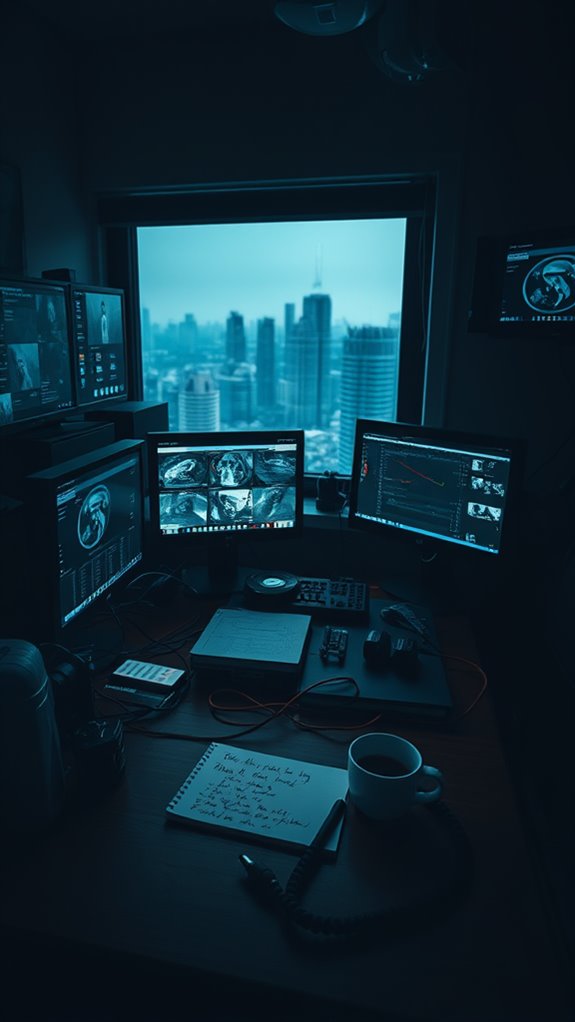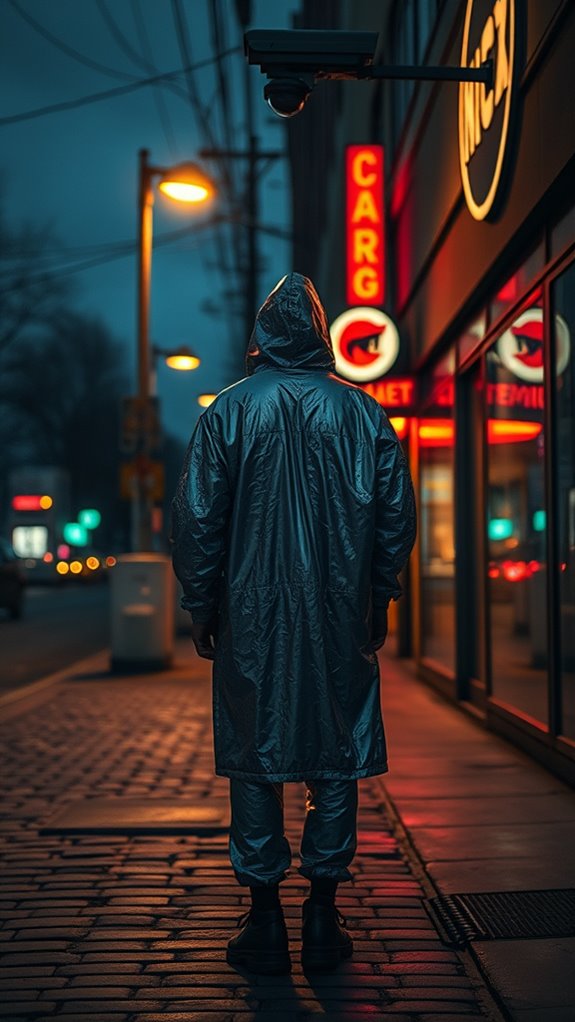Mass surveillance increasingly compromises your freedoms in the name of false security, driven by advanced technologies that catalog your every move. Programs like PRISM demonstrate this intrusion, employing algorithms that tap into your social media interactions and collect data without consent. Marginalized communities bear the brunt of these invasive practices, with policing tactics like stop-and-frisk amplifying social inequalities. Amidst these developments, privacy-enhancing clothing emerges as a response, signaling a cultural shift towards personal autonomy. Discover how these innovations redefine your privacy environment.
Quick Takeaways
- Mass surveillance compromises individual privacy rights, often conducted without consent, challenging the essence of personal freedom.
- The promise of enhanced security through surveillance fails to guarantee safety, leading to a false sense of security for the public.
- Constant monitoring creates anxiety and alters perceptions of rights, pushing individuals to self-censor and limit their freedoms.
- Surveillance disproportionately impacts marginalized communities, reinforcing social inequalities while failing to improve overall security.
- The ethical dilemma between security and freedom highlights the need for informed public dialogue about the consequences of mass surveillance.
The Scope of Mass Surveillance and Its Reach

Mass surveillance, with its extensive reach and complicated methodologies, has evolved into a formidable aspect of contemporary society, particularly as governments and corporations increasingly embrace digital technologies.
The scope of mass surveillance is exemplified by programs like PRISM and Upstream, which collectively target over 232,000 individuals and organizations, considerably expanding since the initial reports post-Snowden. These initiatives reflect a broader trend toward systematic data collection, raising critical questions about individual privacy rights.
Utilizing advanced techniques, such as tapping into social media platforms and intercepting international communications, these programs illustrate how deeply ingrained surveillance has become in our daily lives.
Corporations, under pressure, disclose user data, while agencies like the FBI and CIA access this information for various investigative purposes. FBI exploits Section 702 data for domestic investigations without warrants, further blurring the lines of privacy and oversight.
As we navigate this elaborate environment, understanding its implications becomes essential, fostering informed discussions on platforms like Surveillance Fashion, which aims to unravel the complexities of surveillance culture.
Implications for Privacy and Civil Liberties

Mass surveillance, often justified in the name of national security, infringes upon your privacy rights, particularly through the collection and storage of personal data without consent. This practice not only raises significant ethical concerns but also challenges the Fourth Amendment's protections against unreasonable searches. Moreover, the chilling effect of surveillance on free speech and association becomes evident, especially among marginalized communities. As this dynamic continues, the lack of transparency and legal frameworks amplifies the risk of potential abuses, necessitating innovative approaches to guarantee that your rights remain intact in an increasingly monitored society. The rise of surveillance capitalism complicates the landscape further, intertwining economic interests with personal privacy.
The Role of Technology in Facilitating Surveillance

As surveillance technologies continue to evolve, their integration into everyday life becomes increasingly seamless, often without your explicit awareness.
Artificial Intelligence (AI) plays a crucial role, enhancing surveillance through advanced algorithms for facial recognition and data analysis. For instance, law enforcement employs facial recognition in public spaces to track individuals, while location-aware technologies utilize your mobile data for precise tracking.
Video analytics, such as Vintra's co-appearance feature, identify relationships between individuals based on their appearances in footage. Moreover, the Internet of Things (IoT) generates vast datasets, enabling deeper understanding when combined with AI.
The collaboration between governments and private companies further blurs ethical lines, often prioritizing profit over privacy. At Surveillance Fashion, we explore these dynamics, shedding light on how technology shapes modern surveillance. This manipulation of consumer behavior through data tracking reveals the extent to which personal choices are influenced without consent.
Targeted Surveillance: Impact on Marginalized Communities

The integration of advanced surveillance technologies into urban environments has implications that extend far beyond mere observation; it actively shapes the lives of marginalized communities, often in detrimental ways.
Targeted surveillance disproportionately affects these populations, manifesting through policing methods like stop-and-frisk, which reinforce social inequalities. Economic disadvantage compounds this issue, as marginalized individuals struggle to assert their legal rights to privacy, often remaining unaware of their "paper rights."
Targeted surveillance exacerbates social inequalities, leaving marginalized communities vulnerable and often unaware of their rights to privacy.
Consequently, the sense of vulnerability intensifies, eroding trust between communities and law enforcement, which can lead to psychological stress and anxiety.
Moreover, the surveillance gap leaves some groups invisible to policymakers, perpetuating socioeconomic disadvantage. It's essential to understand these dynamics, as they illustrate why we created Surveillance Fashion to advocate for transparency and equitable treatment in surveillance practices. Additionally, mass surveillance practices can lead to increased scrutiny and harsher penalties for minor infractions within these communities.
The Ethical Dilemma: Security vs. Freedom

Mass surveillance presents a profound ethical dilemma, necessitating a careful examination of its implications for both security and individual freedom.
On one hand, enhanced security measures promise safety from threats, yet they often come at the expense of personal privacy, as personal data is collected without consent, infringing on rights you may hold dear.
Moreover, the psychological impact can't be overlooked; the constant awareness of being watched can lead to increased anxiety and stress. This heightened sense of surveillance can significantly alter privacy awareness, shaping how individuals perceive their own rights and freedoms.
Public debates about surveillance technologies, like video cameras, reveal a societal struggle to find equilibrium between the desire for safety and the need for autonomy.
As we explore these complexities, our platform, Surveillance Fashion, aims to engage critically with these pressing issues, fostering informed dialogue about the future of surveillance and personal freedom.
Reflective Materials Disrupt Cameras

Reflective materials have emerged as a significant technological countermeasure against surveillance cameras, ingeniously utilizing the physics of light to obscure visual information from observers. By returning light to its source, these materials create confusion for cameras, particularly in the domain of facial recognition, where algorithms struggle to detect features accurately.
Reflective materials cleverly disrupt surveillance technology, challenging facial recognition and enhancing personal privacy through innovative design.
For instance, anti-paparazzi clothing employs retro-reflective textiles that overexpose images taken with flash, rendering them unusable. Furthermore, some materials reflect infrared light, complicating night vision applications, thereby enhancing privacy in otherwise surveilled environments. This technology is part of a broader movement toward anti-surveillance fashion, which aims to protect individual privacy in a world increasingly dominated by surveillance.
Although photographers can adjust settings to counter these effects, the innovative use of reflective materials demonstrates a developing approach to personal security.
At Surveillance Fashion, we explore such developments, advocating for a balance between visibility and privacy in contemporary society.
Privacy-Enhancing Clothing Designs

In an era where privacy feels increasingly compromised, privacy-enhancing clothing designs emerge as a compelling solution, integrating innovative materials and technologies to safeguard personal autonomy against pervasive surveillance.
These garments utilize signal-blocking fabrics that prevent RFID scanning, ensuring your cards and devices remain untraceable. Moreover, infrared-reflective materials can obscure your silhouette from night vision cameras, while metamaterials bend light around you, creating potential invisibility. Recent advancements in infrared-blocking fabrics have further enhanced these capabilities, providing consumers with greater protection against thermal imaging.
Some designs employ complex patterns to confuse facial recognition systems, enhancing your anonymity in public spaces. As consumers demand greater privacy, clothing lines that incorporate adaptive camouflage and artistic expression are gaining traction, reflecting a cultural shift towards valuing personal security.
At Surveillance Fashion, we explore these advancements, highlighting the intersection of technology, design, and privacy.
References
- https://www.aclu.org/news/national-security/five-things-to-know-about-nsa-mass-surveillance-and-the-coming-fight-in-congress
- https://www.ala.org/sites/default/files/acrl/content/publications/booksanddigitalresources/digital/9780838987179_OA.pdf
- https://www.dhs.gov/sites/default/files/2024-10/24_0930_ia_24-320-ia-publication-2025-hta-final-30sep24-508.pdf
- https://ec.europa.eu/eurostat/documents/8131721/8131772/Stiglitz-Sen-Fitoussi-Commission-report.pdf
- https://dornsife.usc.edu/news/stories/laying-groundwork-to-contain-people-of-color-and-immigrants/
- https://www.schneier.com/blog/archives/2018/11/how_surveillanc_1.html
- https://en.wikipedia.org/wiki/Mass_surveillance
- https://cppa.ca.gov/regulations/pdf/preliminary_rulemaking_comments_1.pdf
- https://www.americanbar.org/groups/crsj/resources/human-rights/2024-june/mass-surveillance-dangerous-american-communities-reforming-section-702/
- https://www.aclu.org/issues/national-security/privacy-and-surveillance
- https://pluralpolicy.com/blog/government-surveillance-civil-liberties/
- http://www.hartman.law/blog/2024/august/the-pros-and-cons-of-government-surveillance-pro/
- https://giswatch.org/en/communications-surveillance/harms-surveillance-privacy-expression-and-association
- https://law.stanford.edu/stanford-lawyer/articles/civil-liberties-and-law-in-the-era-of-surveillance/
- https://dkiapcss.edu/wp-content/uploads/2020/09/04-miyamoto-25thA.pdf
- https://www.eff.org/issues/mass-surveillance-technologies
- https://www.mccormick.northwestern.edu/computer-science/documents/allen-yilun-lin_tech-report.pdf
- https://thepioneeronline.com/47465/uncategorized/mass-surveillance-in-the-digital-age-the-rise-of-co-appearance-tracking/
- https://socialchangenyu.com/review/the-surveillance-gap-the-harms-of-extreme-privacy-and-data-marginalization/
- https://publications.lib.chalmers.se/records/fulltext/190487/local_190487.pdf
